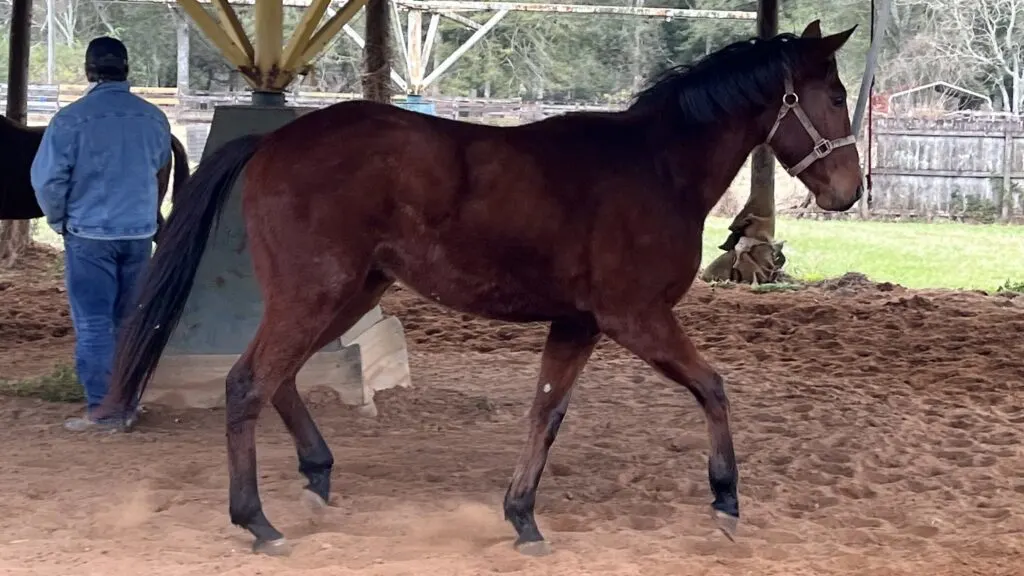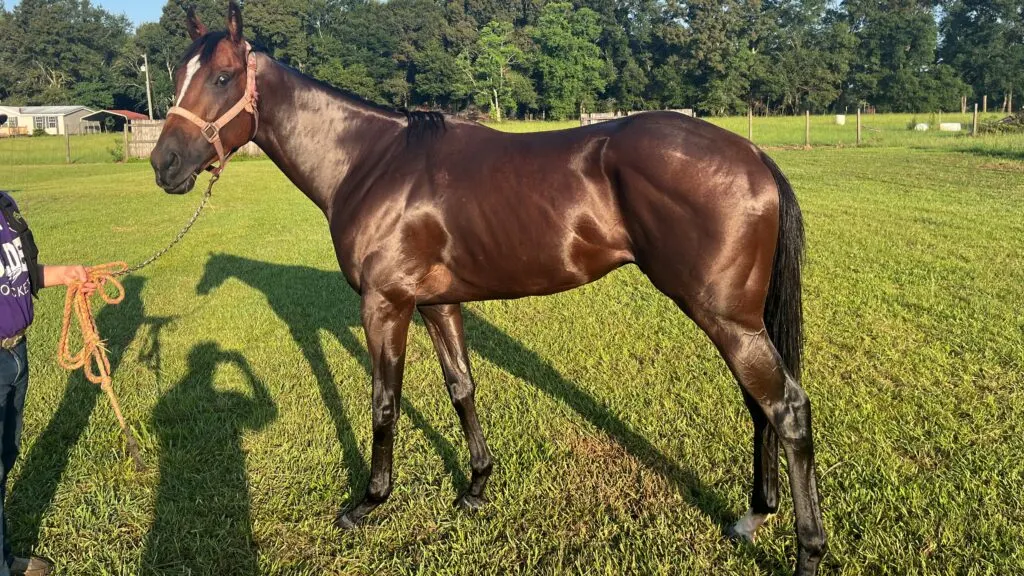Last updated: December 15, 2023
As a horse owner and racing enthusiast for many years, I have had the privilege of experiencing the thrill of thoroughbred racing firsthand. From the high-stakes world of buying and training racehorses to the excitement of watching them thunder down the track, there is something truly special about this sport.
In this article, I’ll take you on a journey through the fascinating world of thoroughbred racing, exploring its rich history, culture, and science. Whether you’re a seasoned fan or just getting started, I hope you’ll join me in discovering the many facets of thoroughbred horse racing.
Overview of Thoroughbred Racing.
Thoroughbreds are known for their athletic ability and are often considered the premier breed for racing. They have a long history of racing, with the first recorded race taking place in England in the early 18th century.

Today, thoroughbred racing is popular worldwide, with major race meets and events held across the United States and in countries such as the United Kingdom, Australia, Japan, and Saudi Arabia.
In addition to live races, thoroughbred racing attracts a significant amount of attention and betting through online and offline channels. Many people enjoy the excitement and thrill of watching live races or placing bets on their favorite horses and trainers.
Overall, thoroughbred horse racing is a popular and exciting sport that draws in fans and participants from around the world.
History of Thoroughbred Racing
The history of thoroughbred horse racing dates back to the early 18th century when the first recorded race occurred in England. The thoroughbred breed was developed in England in the late 17th and early 18th centuries through the selective breeding of Arabian, Turk, and Barb horses with native English mares.
The first official stud book for thoroughbreds was published in 1791, and the rules of thoroughbred racing were codified in the late 18th and early 19th centuries. During this time, horse racing became an increasingly popular sport in England and the rest of Europe.
The first recorded horse race in the United States took place in 1665. However, it was not until the importation of thoroughbreds from England in the late 18th and early 19th centuries that the sport of thoroughbred racing really took off in the US.
Throughout the 19th and 20th centuries, thoroughbred racing grew in popularity and expanded to new locations worldwide. Today, major thoroughbred racing events are held across the globe.

The Culture of Thoroughbred Racing.
Thoroughbred racing has a rich and unique culture that is steeped in tradition and history. One aspect of the culture of thoroughbred racing is the famous tracks and races that are held around the world.
Some of the most well-known thoroughbred races include the Kentucky Derby in the United States, the Epsom Derby in England, and the Melbourne Cup in Australia.
These events often attract a large and passionate fan base. They are often accompanied by diverse cultural traditions and rituals, such as the mint juleps served at the Kentucky Derby and the floral headdresses worn at the Epsom Derby.
Gambling and betting on races are also an integral part of the culture of thoroughbred racing. In many places, betting on horse races is legal and regulated, and many people enjoy the excitement and thrill of placing bets on their favorite horses and trainers.
Overall, the culture of thoroughbred racing is a diverse and fascinating blend of tradition, competition, and excitement.
Here is a YouTube video explaining the characteristics of a good racehorse.
The Science Behind Thoroughbred Racing.
The science behind thoroughbred racing plays a crucial role in the breeding, training, and care of racehorses. One element of the science of thoroughbred racing is the breeding and genetics of horses.
Thoroughbreds are carefully bred to produce offspring with the desired traits for racing, such as speed, stamina, and athleticism. Scientists and breeders use assorted tools and techniques, including genetic testing and analysis, to understand and optimize the speed of thoroughbreds.
Another aspect of the science of thoroughbred racing is the training and conditioning of racehorses. Trainers use different methods and techniques to prepare horses for racing, including exercise, diet, and rest.
They may also use specialized equipment and facilities, such as treadmills and swimming pools, to help build the strength and endurance of their horses. In addition to trainers, veterinarians and other equine specialists play key roles in the science of thoroughbred racing.
They are responsible for the care and well-being of the horses, including preventing and treating injuries and illnesses. The science behind thoroughbred racing is a complex and important field that helps ensure racehorses’ health and performance.

The Thrill of the Race
One of the most exciting aspects of thoroughbred racing is the thrill of the race itself. Watching horses thunder down the track at high speeds, with jockeys urging them on, can be an exhilarating experience.
The excitement of thoroughbred racing is not just limited to live events. Many people also enjoy watching races on television or online, and the sport attracts a significant amount of betting and gambling.
The outcome of a thoroughbred race can be influenced by numerous factors, including the skill and strategy of the jockeys, the conditioning and training of the horses, and the specific conditions of the track. This adds to the thrill of the race, as spectators never know for certain who will come out on top.
The thrill of the race is one of the main draws of thoroughbred racing and is a key part of what makes it such a popular and exciting sport.
Roles of Trainers and Jockeys in Thoroughbred Racing.
Trainers and jockeys play crucial roles in the world of thoroughbred racing, and they face various physical and mental challenges in their work. Trainers are responsible for the care and conditioning of racehorses, including their feeding, exercise, and rest.
They also select which races their horses will enter and develop strategies for how they will be ridden. One strategy that trainers use is to select races for their horses based on factors such as the race’s distance, the track’s surface, and the horse’s capabilities.
They may also develop training and conditioning regimes to prepare their horses for specific races. Trainers must be knowledgeable about the capabilities and needs of their horses, as well as the specific requirements of different races and tracks.

Jockeys are the riders of the horses in races. They must be physically fit and agile, as they must be able to control and guide the horses at high speeds. Jockeys must also be mentally tough, making split-second decisions during races and handling high competition pressure.
During a race, jockeys use assorted strategies to guide their horses to victory. These may include positioning the horse within the pack, making strategic moves to pass other horses, and timing their final push to the finish line.
Jockeys must also be able to respond to changing conditions and tactics of other riders during the race. Both trainers and jockeys must also be able to work well as part of a team and must be able to communicate effectively with each other and with the owners of the horses.
Trainers and jockeys have essential and demanding roles in the world of thoroughbred racing, and they must meet various physical and mental challenges to succeed.
Role of Veterinarians in the Care and Well-being of Racehorses
Veterinarians and other team members play a crucial role in the care and well-being of racehorses. These professionals are responsible for providing the horse with medical treatment and preventative care to keep them healthy and fit for racing.

The horse pictured above began losing weight, and our vet prescribed a daily dewormer and added vitamin supplements to its daily rations. It has helped him.
Some of the tasks that veterinarians and other medical professionals may perform in the care of racehorses include:
- Conducting physical examinations to identify any health issues or injuries
- Administering medications and treatments to treat or prevent illness and injury
- Providing first aid and emergency care as needed
- Advising trainers on the health and conditioning of their horses
- Providing specialized care such as chiropractic or acupuncture treatment
In addition to veterinarians, other medical professionals such as farriers (blacksmiths who specialize in shoeing horses) and massage therapists may also be involved in the care and well-being of racehorses.

Conclusion
In conclusion, the fascinating world of thoroughbred horse racing is a complex and exciting sport with rich history, culture, and science. From the early development of the thoroughbred breed to the thrill of live races, many aspects of thoroughbred racing make it a compelling and captivating sport.
Whether you are a fan of horse racing, a participant, or just learning about it for the first time, there is much to discover and enjoy in the world of thoroughbred racing. From the intense competition and strategy of the races to the rich cultural traditions and rituals surrounding them, thoroughbred racing has something for everyone.
FAQs
What is the most famous racehorse in history?
Many famous racehorses have existed throughout history, and it’s difficult to determine the “most” famous one. Here are a few of the most well-known racehorses in history: Secretariat, Man o’ War, Seabiscuit, and Frankel.
Why is it called a Thoroughbred horse?
Thoroughbred horses are called “thoroughbreds” because they are bred from purebred ancestors. The term “thoroughbred” refers to the fact that these horses have a pedigree that can be traced back to a few foundation sires and dams.
